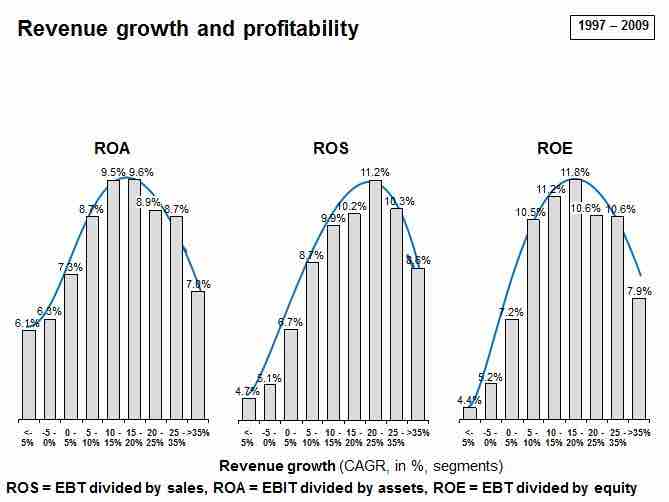Internal Growth and Sustainability
The true benefit of a high return on equity arises when retained earnings are reinvested into the company's operations. Such reinvestment should, in turn, lead to a high rate of growth for the company. The internal growth rate is a formula for calculating maximum growth rate that a firm can achieve without resorting to external financing. It's essentially the growth that a firm can supply by reinvesting its earnings. This can be described as (retained earnings)/(total assets), or conceptually as the total amount of internal capital available compared to the current size of the organization.
We find the internal growth rate by dividing net income by the amount of total assets (or finding return on assets) and subtracting the rate of earnings retention. However, growth is not necessarily favorable. Expansion may strain managers' capacity to monitor and handle the company's operations. Therefore, a more commonly used measure is the sustainable growth rate.
Sustainable growth is defined as the annual percentage of increase in sales that is consistent with a defined financial policy, such as target debt to equity ratio, target dividend payout ratio, target profit margin, or target ratio of total assets to net sales.
We find the sustainable growth rate by dividing net income by shareholder equity (or finding return on equity) and subtracting the rate of earnings retention. While the internal growth rate assumes no financing, the sustainable growth rate assumes you will make some use of outside financing that will be consistent with whatever financial policy being followed. In fact, in order to achieve a higher growth rate, the company would have to invest more equity capital, increase its financial leverage, or increase the target profit margin.
Optimal Growth Rate
Another measure of growth, the optimal growth rate, assesses sustainable growth from a total shareholder return creation and profitability perspective, independent of a given financial strategy. The concept of optimal growth rate was originally studied by Martin Handschuh, Hannes Lösch, and Björn Heyden. Their study was based on assessments on the performance of more than 3,500 stock-listed companies with an initial revenue of greater than 250 million Euro globally, across industries, over a period of 12 years from 1997 to 2009.

Revenue Growth and Profitability
ROA, ROS and ROE tend to rise with revenue growth to a certain extent.
Due to the span of time included in the study, the authors considered their findings to be, for the most part, independent of specific economic cycles. The study found that return on assets, return on sales and return on equity do in fact rise with increasing revenue growth of between 10% to 25%, and then fall with further increasing revenue growth rates. Furthermore, the authors attributed this profitability increase to the following facts:
- Companies with substantial profitability have the opportunity to invest more in additional growth, and
- Substantial growth may be a driver for additional profitability, whether by attracting high performing young professionals, providing motivation for current employees, attracting better business partners, or simply leading to more self-confidence.
However, according to the study, growth rates beyond the "profitability maximum" rate could bring about circumstances that reduce overall profitability because of the efforts necessary to handle additional growth (i.e., integrating new staff, controlling quality, etc).